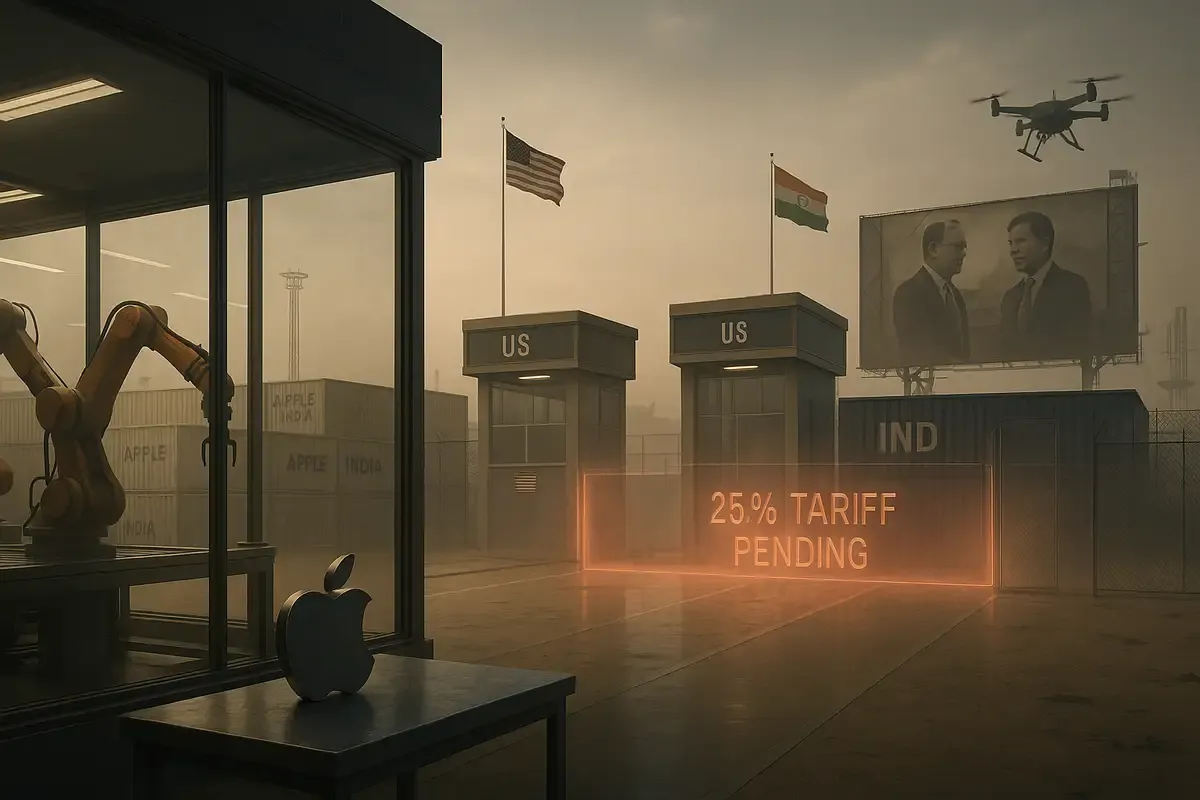💡 TL;DR - The 30 Seconds Version
🎯 Trump announced 25% tariffs on India effective Friday, threatening Apple's $40 billion iPhone production strategy there.
📉 Apple stock dropped 17% this year while expecting just 2.4% profit growth versus the tech sector's 16.8% surge.
🏭 India now supplies 71% of US iPhones, up from 31% last year, with Foxconn exporting $3.2 billion in three months alone.
🤖 Apple's AI strategy lags competitors as delayed features and licensing talks show the company playing catch-up for once.
💰 The stock trades at 28 times earnings despite mature-company results, creating a valuation gap that could take years to close.
🚫 Apple can't easily move production back to the US or elsewhere, leaving it trapped between political risks and limited alternatives.
Apple reports earnings Thursday with little to celebrate. The company's stock has dropped 17% this year while the broader tech sector soars on AI enthusiasm. Investors expected more from a company trading at 28 times earnings—well above its 10-year average of 21 times.
The numbers tell a grim story. Apple expects quarterly profit growth of just 2.4% and revenue growth of 4.1%. Compare that to the tech sector's projected 16.8% earnings growth and 13% revenue jump. Apple ranks among the 15 worst performers in the Nasdaq 100 this year.
"Apple's embarrassing AI shows how it has lost its mojo with innovation," said Peter Andersen, founder of Andersen Capital Management. The lack of innovation translates directly to weak revenue growth, which explains why the stock can't maintain its premium valuation.
The AI Problem Gets Worse
Apple's artificial intelligence strategy looks increasingly desperate. The company unveiled AI features at its June developer conference, but most have been delayed or underwhelmed users. Internal discussions now include licensing AI technology from outside companies—something Apple historically avoided.
The company has reportedly considered buying AI startup Perplexity. That's a far cry from Apple's usual preference for building everything in-house. Meanwhile, competitors like Microsoft, Meta, and Alphabet posted strong results this week, powered by their AI investments.
Apple's Siri assistant still feels dated compared to ChatGPT or Google's Bard. The company that once defined consumer technology now trails in the industry's most important shift since the smartphone.
India Becomes Apple's Lifeline
One bright spot emerged over the past four years: India. Apple moved significant iPhone production there after COVID disrupted its China supply chain. The strategy worked better than anyone expected.
India now supplies 71% of all iPhones sold in the US market, up from 31% a year earlier. The country accounts for more than 20% of global iPhone production—roughly $40 billion worth of devices headed to American consumers. Just in those three months from March to May, Foxconn shipped $3.2 billion worth of iPhones from India to America.
Apple cut its China dependence and found cheaper workers. Indians earn half what Chinese workers make, and parts suppliers moved in to serve Apple's factories.
Trump's Tariff Bomb
President Trump announced 25% tariffs on Indian goods Wednesday, effective Friday. The timing couldn't be worse for Apple, which has spent years building its India supply chain.
Currently, smartphones and electronics avoid these tariffs thanks to exemptions from April. But those exemptions could disappear. The Commerce Department is probing sectors like semiconductors under national security provisions. When those reviews finish, expect new levies on a range of foreign-made products.
Trump has targeted Apple specifically before, criticizing the company for manufacturing outside the US. In May, he recalled telling CEO Tim Cook: "we put up with all the plants you built in China for years... we are not interested in you building in India, India can take care of themselves."
Nowhere Left to Run
Apple faces an impossible choice. It can't easily move iPhone production back to the US—the country lacks the factories, trained workers, and supplier networks needed for mass production. Even if those existed, most components would still need importing, creating tariff exposure anyway.
Moving production elsewhere isn't simple either. Apple has invested heavily in India over four years. The supply chain relationships, worker training, and government partnerships can't be replicated quickly in Vietnam or other alternatives.
Analysts at Evercore worry Apple may have no choice but to absorb higher costs if India tariffs stick. The company could pass those costs to consumers, but that risks hurting demand for already expensive iPhones.
"Making supply chain adjustments, particularly with new iPhone models nearing release, is unlikely due to the complex factors involved," said Tarun Pathak at Counterpoint Research. Apple's supply chain has become too complex to pivot quickly.
The Premium Problem
Apple's valuation adds pressure to every decision. The stock trades at 28 times estimated earnings—higher than Alphabet, Meta, or Amazon, despite their stronger AI positions. Investors pay a premium for growth that increasingly looks unrealistic.
The company has spent 98 sessions below its 200-day moving average, matching its longest streak since February 2023. Another close below that technical level would mark the longest such stretch in almost a decade.
Bank of America describes sentiment toward Apple as "fairly negative"—a dramatic shift for a former consensus favorite. The combination of weak growth and high valuation creates a toxic mix for investors seeking better opportunities in AI-focused competitors.
Management Under Fire
Some investors want dramatic changes. They're calling for management shakeups or major acquisitions—moves that would represent a sharp break from Apple's traditional approach. The company's reluctance to adapt quickly to AI has frustrated shareholders who remember when Apple led technological shifts rather than followed them.
Apple's cash hoard gives it options, but the company has historically preferred organic growth to big purchases. That conservative approach looks outdated when competitors are racing to acquire AI capabilities and talent.
Why this matters:
• Apple bet big on India to escape China problems. Now tariffs threaten that strategy right when AI troubles are hurting growth. The company has few good choices left.
• Investors pay growth-stock prices for Apple but get old-company results. That mismatch won't fix itself without big changes.
❓ Frequently Asked Questions
Q: Why can't Apple just move iPhone production back to the United States?
A: America doesn't have iPhone factories. We don't have workers who know how to build them at scale. Most parts still come from Asia anyway, so tariffs would hit those too. Building all this from scratch? That's a decades-long project.
Q: What are these electronics exemptions that protect iPhones from tariffs?
A: Trump's team said in April that phones and computers get a pass on tariffs since America doesn't make them. But that protection could vanish when the Commerce Department finishes its security reviews.
Q: How much would a 25% tariff actually add to iPhone prices?
A: Probably $200-300 more per phone if Apple passes the full cost to buyers. But Apple might eat some of that cost to keep sales up, which would crush their profit margins instead.
Q: How does Apple's stock valuation compare to other tech giants?
A: Apple trades at 28 times earnings while Alphabet, Meta, and Amazon trade lower despite stronger AI positions. Apple's valuation exceeds its 10-year average of 21 times earnings, making it expensive for its growth rate.
Q: What specific AI features has Apple delayed or struggled with?
A: Apple unveiled AI features at its June developer conference, but most have been delayed or underwhelmed users. The company is reportedly considering licensing outside AI technology and has discussed acquiring AI startup Perplexity to catch up.
Q: How long did it take Apple to build up its India production?
A: Apple spent four years building its India operations after COVID disrupted its China supply chain. The complex supplier relationships, worker training, and government partnerships can't be easily replicated in other countries.
Q: What does "98 sessions below 200-day moving average" mean for Apple's stock?
A: This technical indicator shows Apple's stock has closed below its average price over the past 200 trading days for 98 consecutive sessions. It signals weak momentum and matches Apple's longest such streak since February 2023.
Q: What other countries could Apple move iPhone production to besides India?
A: Vietnam is the main alternative, but it lacks India's scale and established supplier network. Building new production capacity elsewhere would take years and still face potential tariff risks under Trump's broad trade policies.








